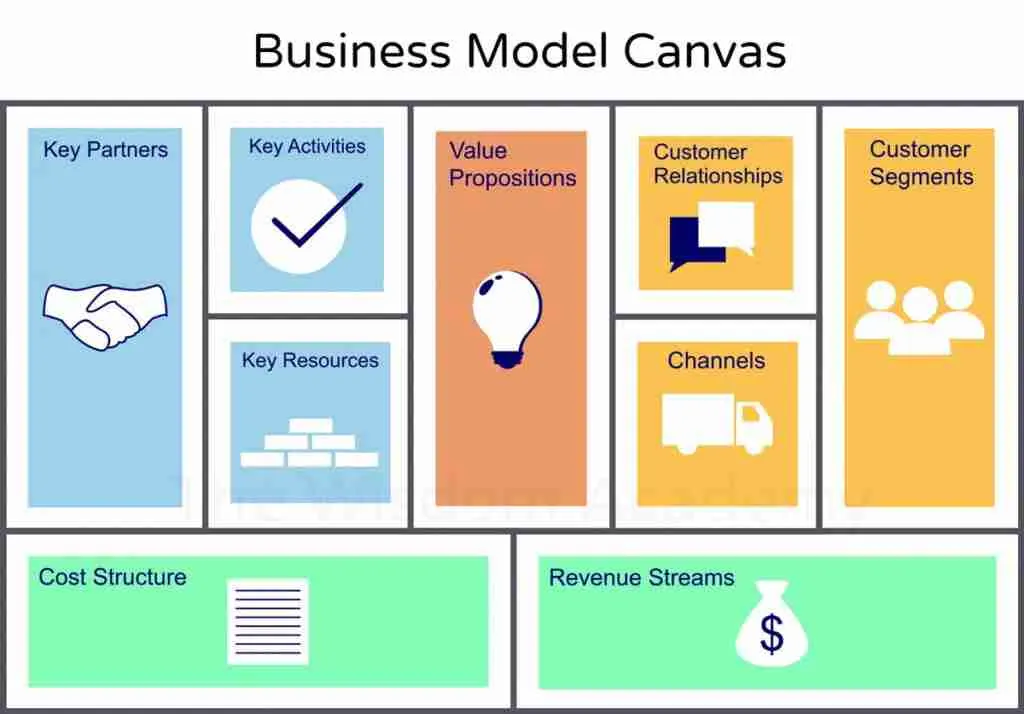Let me tell you a secret. Most businesses don’t fail because the product was bad. They fail because the business model was broken—or worse—non-existent. You know the type: great ideas buried under jargon, vague strategies, and a business plan that looks like it was written for a government grant, not actual sales.
Now here’s where the Business Model Canvas walks in—like a Navy SEAL in a hostage situation. It doesn’t care about your 40-page PowerPoint deck. It doesn’t need a SWOT analysis from the Stone Age. It wants one thing: clarity. In one single page. Nine building blocks. Zero fluff.
Let’s break it down like entrepreneurs who have payroll to meet and customers to serve—not academics trying to impress their peers.
1. Customer Segments – Who’s your tribe?
You don’t sell to “everyone.” That’s the first lie entrepreneurs tell themselves before their bank account starts resembling a horror story. Think about Henry Ford. He didn’t try to sell the Model T to aristocrats. He built it for the everyday American—cheap, reliable, fast. Boom. Market segment nailed.
Your job? Find your tribe. Serve them like royalty. Ignore the rest.
2. Value Propositions – Why should anyone care?
This is the atomic core. The heartbeat. The “why you” in a world drowning in options. Think Domino’s in the ‘80s: “Fresh, hot pizza delivered in 30 minutes or less—or it’s free.” Not just pizza. A value promise so powerful it changed the game.
Craft yours like your life depends on it—because your business does.
3. Channels – How will you deliver the goods?
The greatest product in the world dies in obscurity without a delivery system. Jeff Bezos didn’t invent shopping. He just made it 10x easier. That’s a channel masterclass. Your channels are how you get into your customers’ hands, hearts, and minds.
Online? Retail? Carrier pigeon? Whatever it is, own it.
4. Customer Relationships – Robots or real humans?
You can’t automate your way into loyalty (unless your name is Elon). Relationships are currency. How do you keep them coming back? Do you offer onboarding like a warm handshake or a cold slap? Think Zappos—insane customer service turned them into an empire.
Give a damn. It pays.
5. Revenue Streams – Show me the money.
Let’s be clear: revenue is not a dirty word. If you’re not making money, you’re running a charity with an identity crisis. Will you sell one-time? Subscriptions? Licenses? Freemium-to-premium? Choose wisely.
Michelin didn’t just sell tires. They created a travel guide so people would use their tires more. That’s business model judo.
6. Key Resources – What do you absolutely need to win?
Every empire is built on something: land, labor, knowledge, or leverage. What are your non-negotiables? Airbnb didn’t own property. But they had tech, trust, and a platform.
Know what makes your engine run. Fuel it relentlessly.
7. Key Activities – What must you do every single day?
What’s your “main thing”? If you’re a logistics company, it’s moving stuff fast. If you’re Netflix, it’s creating binge-worthy content. Your focus should be surgical.
Do fewer things. But do them better than anyone else.
8. Key Partnerships – Who’s got your missing pieces?
You’re not a superhero. You can’t fly solo. Apple needed Foxconn. Nike needs factories. Even Pablo Escobar needed smugglers. Who can you align with to scale, save costs, or dominate?
Make alliances that move the needle, not just look pretty on LinkedIn.
9. Cost Structure – What’s bleeding you dry?
Know your cost structure like you know your Netflix password. Fixed vs. variable, lean vs. bloated—this is your survival math. Southwest Airlines? Low-cost kings because they fly one aircraft type. Less complexity. More profit.
Cut the fat. Keep the muscle.
The Bottom Line?
The Business Model Canvas isn’t a form. It’s a mirror. It forces you to confront your business, stripped naked of buzzwords and bull. Use it to simplify. Use it to test. Use it to pivot before you perish.
History rewards those who master the model. The rest? They write long business plans no one reads.
So grab a marker. Fill that canvas. And for heaven’s sake—sell something people actually want.
P.S. If you can’t explain your business model to a 12-year-old in under 60 seconds, you don’t have one. You have a hallucination.
Now go fix it.
Author

He's a talented Project Director @Brightery, studied in different colleges and working with Udjat UAE as CMO, writes in Project Management, Marketing, Digital Marketing and technical software development.






